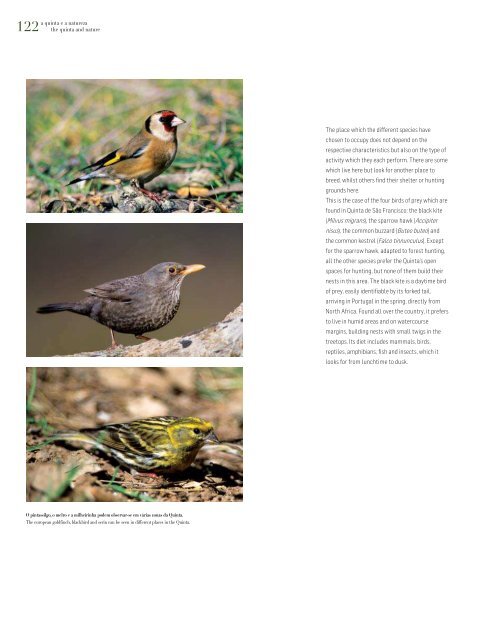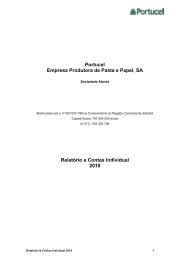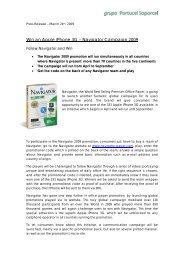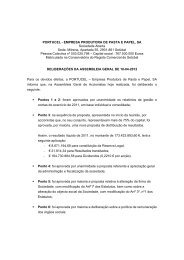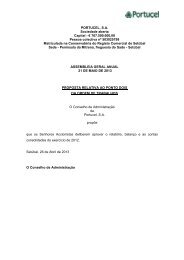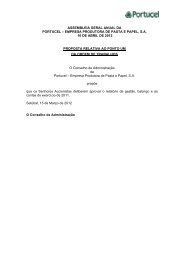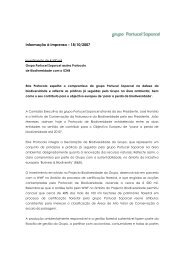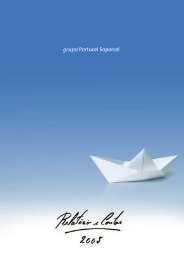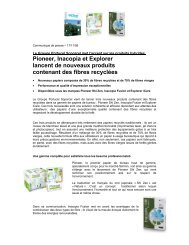Os Eucaliptos e as Aves da Quinta de São Francisco
Os Eucaliptos e as Aves da Quinta de São Francisco
Os Eucaliptos e as Aves da Quinta de São Francisco
Create successful ePaper yourself
Turn your PDF publications into a flip-book with our unique Google optimized e-Paper software.
a quinta e a natureza<br />
a quinta e a natureza<br />
122 the quinta and nature the quinta and nature 123<br />
O pint<strong>as</strong>silgo, o melro e a milheirinha po<strong>de</strong>m observar-se em vári<strong>as</strong> zon<strong>as</strong> <strong>da</strong> <strong>Quinta</strong>.<br />
The european goldfinch, blackbird and serin can be seen in different places in the <strong>Quinta</strong>.<br />
The place which the different species have<br />
chosen to occupy does not <strong>de</strong>pend on the<br />
respective characteristics but also on the type of<br />
activity which they each perform. There are some<br />
which live here but look for another place to<br />
breed, whilst others find their shelter or hunting<br />
grounds here.<br />
This is the c<strong>as</strong>e of the four birds of prey which are<br />
found in <strong>Quinta</strong> <strong>de</strong> <strong>São</strong> <strong>Francisco</strong>: the black kite<br />
(Milvus migrans), the sparrow hawk (Accipiter<br />
nisus), the common buzzard (Buteo buteo) and<br />
the common kestrel (Falco tinnunculus). Except<br />
for the sparrow hawk, a<strong>da</strong>pted to forest hunting,<br />
all the other species prefer the <strong>Quinta</strong>’s open<br />
spaces for hunting, but none of them build their<br />
nests in this area. The black kite is a <strong>da</strong>ytime bird<br />
of prey, e<strong>as</strong>ily i<strong>de</strong>ntifiable by its forked tail,<br />
arriving in Portugal in the spring, directly from<br />
North Africa. Found all over the country, it prefers<br />
to live in humid are<strong>as</strong> and on watercourse<br />
margins, building nests with small twigs in the<br />
treetops. Its diet inclu<strong>de</strong>s mammals, birds,<br />
reptiles, amphibians, fish and insects, which it<br />
looks for from lunchtime to dusk.<br />
Também o peneireiro escolhe <strong>as</strong> hor<strong>as</strong> quentes<br />
do dia para caçar e a sua dieta é semelhante à<br />
do milhafre. Quando caça, o peneireiro fica<br />
parado no ar, batendo <strong>as</strong> <strong>as</strong><strong>as</strong> rapi<strong>da</strong>mente, num<br />
movimento baptizado como «peneirar». Trata-se<br />
<strong>de</strong> um falcão, <strong>de</strong> dimensão média, <strong>de</strong> <strong>as</strong><strong>as</strong> e<br />
cau<strong>da</strong> comprid<strong>as</strong>, cuj<strong>as</strong> pen<strong>as</strong> do dorso e face<br />
superior são <strong>de</strong> um c<strong>as</strong>tanho-alaranjado.<br />
Presente em habitats que vão <strong>da</strong> planície às<br />
zon<strong>as</strong> montanhos<strong>as</strong>, p<strong>as</strong>sando pelos terrenos<br />
<strong>de</strong> cultivo, evita manch<strong>as</strong> florestais extens<strong>as</strong>.<br />
É <strong>de</strong> crer que o c<strong>as</strong>al <strong>de</strong> águi<strong>as</strong>-<strong>de</strong>-<strong>as</strong>a-redon<strong>da</strong><br />
que frequenta a <strong>Quinta</strong> tenha o seu ninho n<strong>as</strong><br />
proximi<strong>da</strong><strong>de</strong>s já que no Verão é possível escutar<br />
o chamamento d<strong>as</strong> cri<strong>as</strong>. Esta é uma espécie<br />
que faz a postura sempre no mesmo ninho,<br />
que restaura todos os anos. Em Portugal está<br />
dispersa por todo o País, elegendo a copa dos<br />
pinheiros bravos para construir o ninho. No início<br />
<strong>de</strong> Abril o c<strong>as</strong>al começa a restaurá-lo e a<br />
incubação dos ovos, feita pelo c<strong>as</strong>al, prolonga-se<br />
por um período <strong>de</strong> 35 di<strong>as</strong>. Tem na sua dieta<br />
ratos, lagartos, insectos e <strong>as</strong> su<strong>as</strong> larv<strong>as</strong>, bem<br />
como coelhos os quais, <strong>de</strong>pois <strong>de</strong> um longo<br />
período <strong>de</strong>saparecidos <strong>da</strong> <strong>Quinta</strong> voltaram agora<br />
a ser observados. Numa primeira f<strong>as</strong>e a fêmea<br />
corta <strong>as</strong> pres<strong>as</strong> capturad<strong>as</strong> para <strong>as</strong> <strong>da</strong>r às cri<strong>as</strong>,<br />
p<strong>as</strong>sando <strong>de</strong>pois a ser os juvenis a cortar o seu<br />
próprio alimento. <strong>Os</strong> adultos caçam n<strong>as</strong> áre<strong>as</strong><br />
abert<strong>as</strong> dos campos agrícol<strong>as</strong> que fazem<br />
fronteira com a <strong>Quinta</strong>, bem como no interior <strong>da</strong><br />
proprie<strong>da</strong><strong>de</strong>. A águia-<strong>de</strong>-<strong>as</strong>a-redon<strong>da</strong> distingue-<br />
-se pela silhueta compacta, com <strong>as</strong><strong>as</strong> larg<strong>as</strong> e<br />
cau<strong>da</strong> aberta em leque.<br />
The kestrel also chooses the hottest time of the<br />
<strong>da</strong>y to hunt and its diet is similar to that of the<br />
kite. When it hunts, the kestrel hovers in the air,<br />
rapidly flapping its wings, in a movement known<br />
<strong>as</strong> “hovering”. It is a medium-sized falcon, with<br />
long wings and tail, whose back and upper<br />
surface feathers are orangey brown. It is found in<br />
habitats ranging from plains to mountainous<br />
regions, including farmed grounds but avoiding<br />
extensively forested are<strong>as</strong>.<br />
It is believed that the common buzzard couple,<br />
which visits the <strong>Quinta</strong>, h<strong>as</strong> its nest in the vicinity<br />
because it is possible to hear the young calling in<br />
the summer. This species lays its eggs always in<br />
the same nest, which it restores every year. It is<br />
scattered throughout Portugal, choosing the<br />
maritime pine crowns on which to build its nests.<br />
In the beginning of April, the couple starts<br />
restoring it and the egg incubation by the couple,<br />
extends over a 35-<strong>da</strong>y period. Its diet inclu<strong>de</strong>s<br />
mice, lizards, insects and their larva, <strong>as</strong> well <strong>as</strong><br />
rabbits, which disappeared from the <strong>Quinta</strong> for a<br />
long period but have now returned. Firstly, the<br />
female tears up the captured prey to feed her<br />
young, whilst later on the young feed themselves.<br />
Adults hunt in the covered are<strong>as</strong> of the<br />
neighbouring farmed lands which bor<strong>de</strong>r the<br />
<strong>Quinta</strong> <strong>as</strong> well <strong>as</strong> in the property’s grounds. The<br />
common buzzard is differentiated by its compact<br />
silhouette, its broad wings and fanlike tail.


